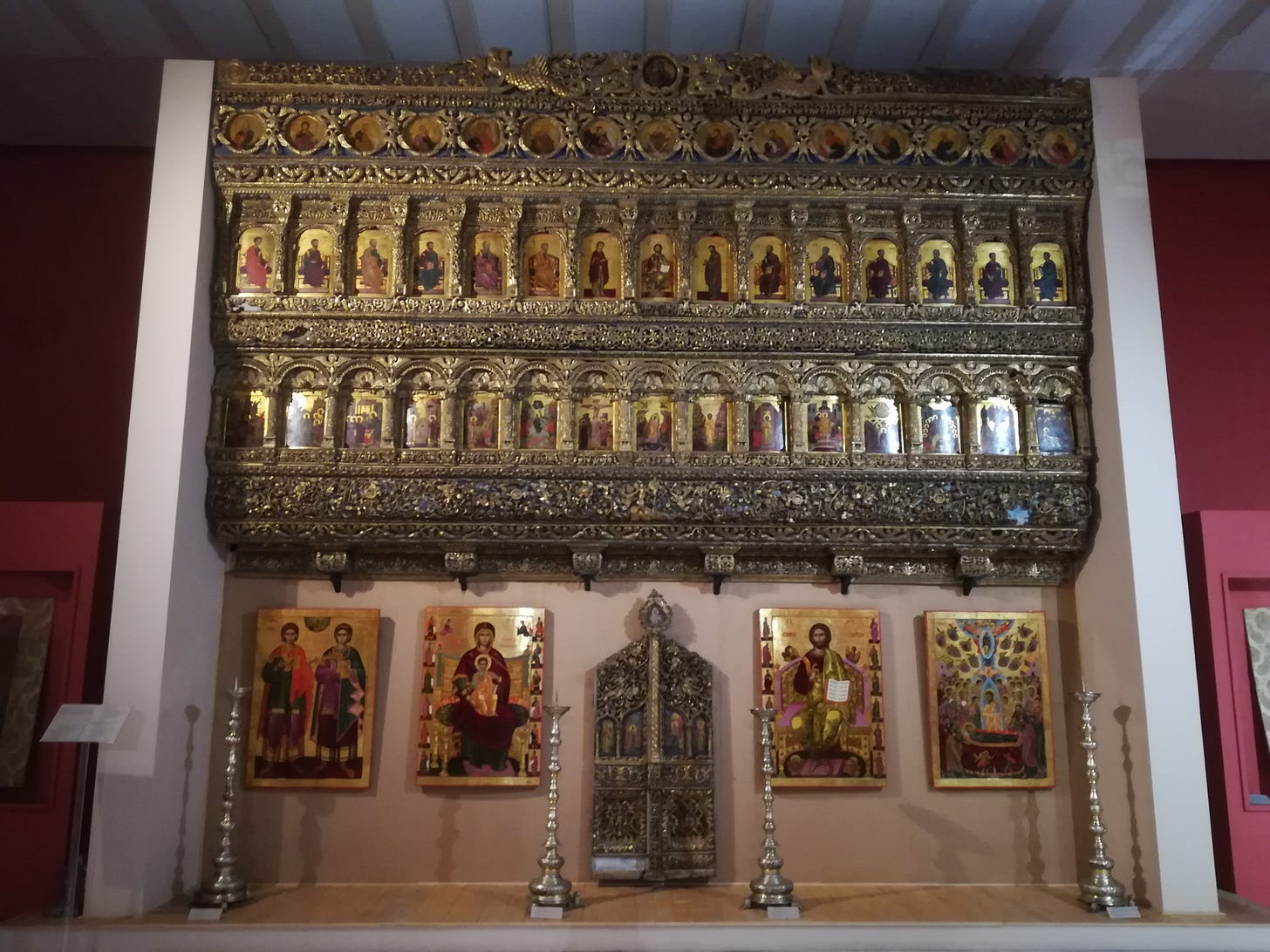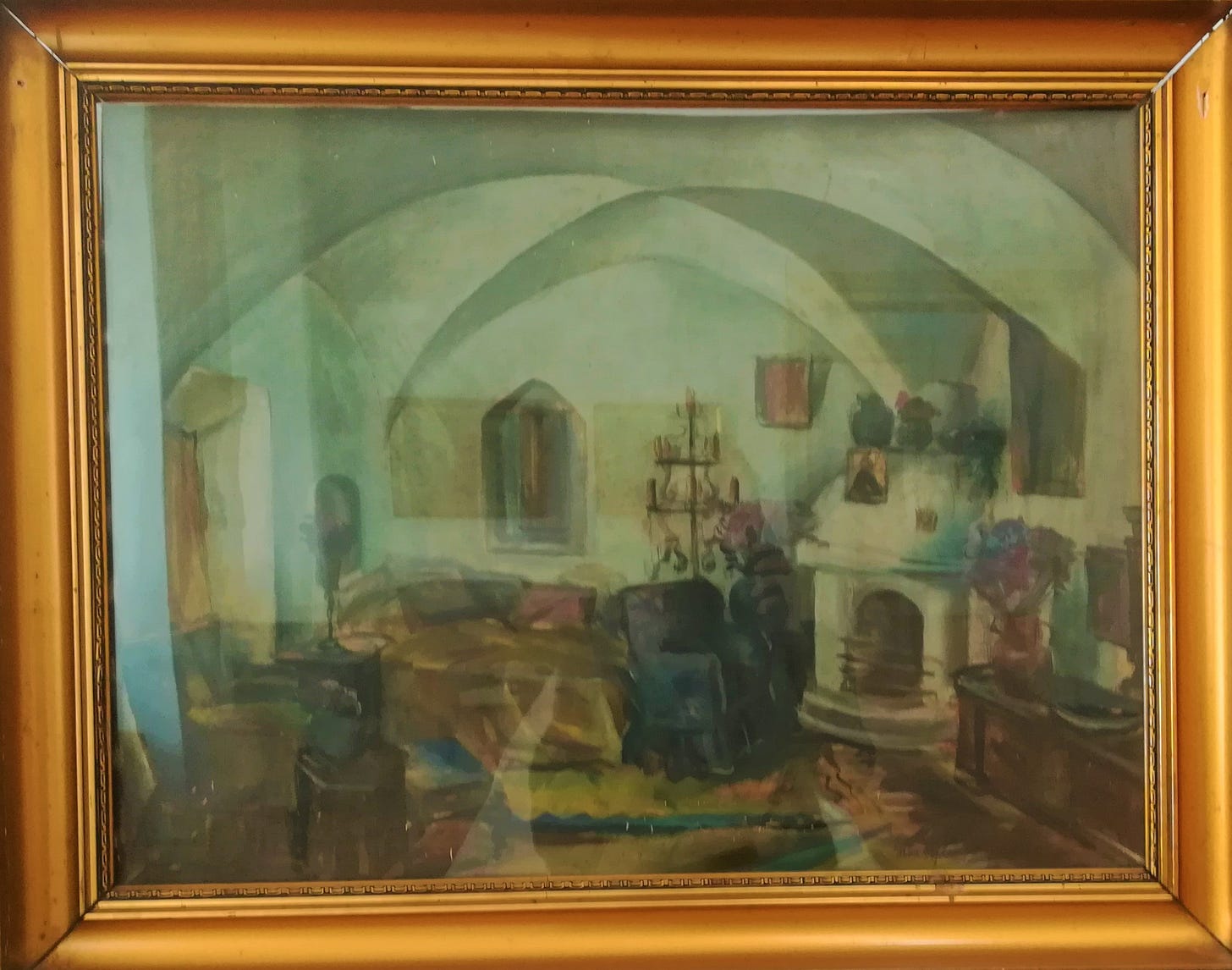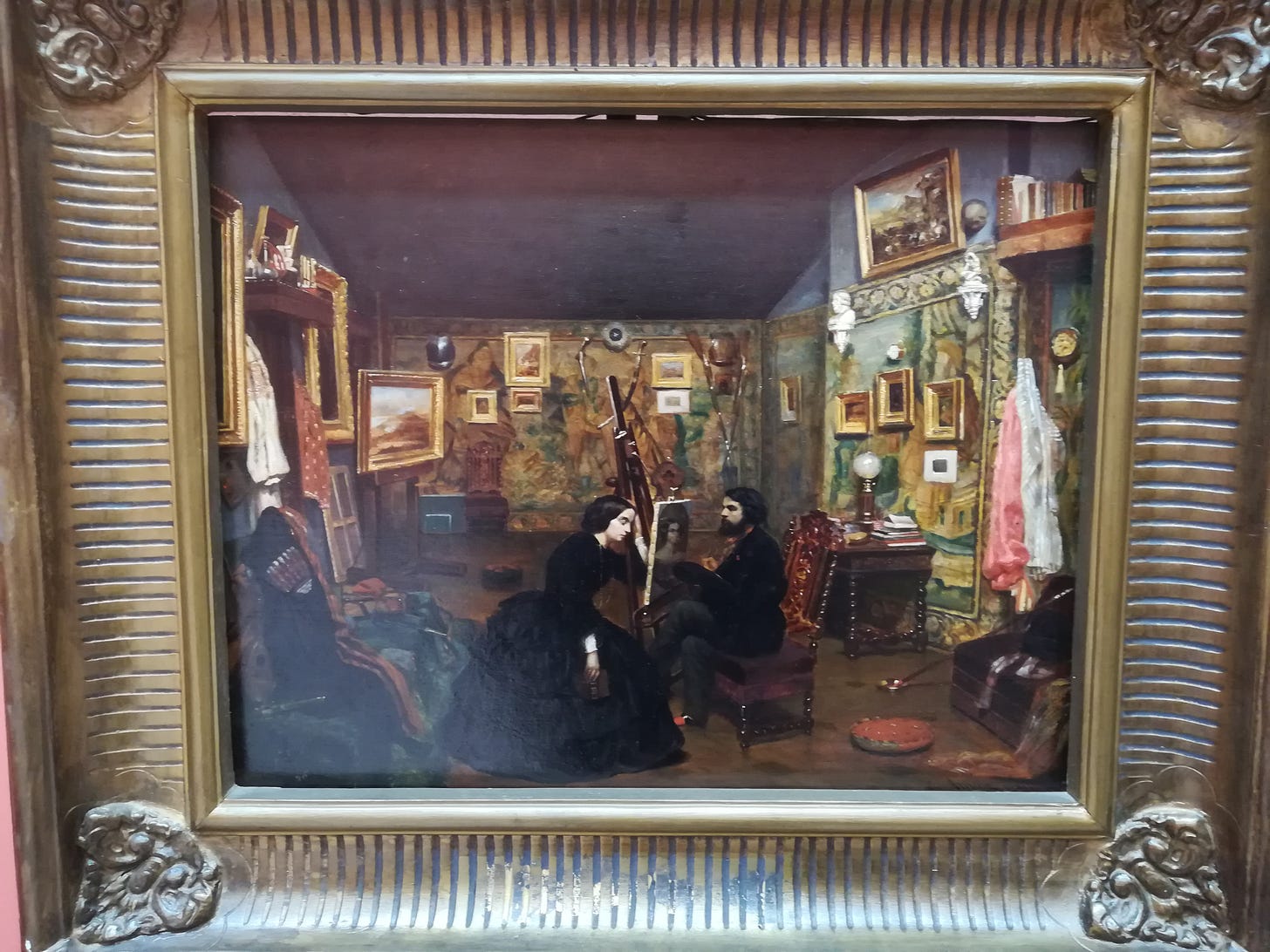It was a sunny Friday afternoon when I stepped into Giles Eldridge’s studio in the Atelierele Malmaison (Malmaison Studios), in Bucharest. By my side was Mihaela Vezentan née Moldovan, whom I had contacted after having seen her work at the White Cuib gallery in Cluj-Napoca last week. She had kindly invited me to her and her husband’s studio, and had shown me around the building, knocking on doors, and introducing me to several of the artists working there.
Founded a couple of years ago, the Malmaison Studios occupy two floors of a large building on Calea Plevnei. Initially built as a garrison, and subsequently used as a military training institution, a military courthouse and a transit and interrogation centre during the early Communist era, it was left in a state of disrepair until the artists took it over. Thoroughly renovating it, fixing the broken windows, giving the walls fresh layers of paint, laying down new floorboards, insulating the rooms as well as they could with their limited means, they ultimately turned the grim derelict building into an artistic community and a place of creation, with studios, galleries and project spaces, thus writing a new - and brighter - chapter in the building’s history.
Giles Eldridge is one of the artists involved in the project. Trained in Sheffield, he lived and worked in London for nearly twenty years, before ending up in Bucharest, out of curiosity, circumstance and a bit of chance - from my understanding at least. Similarly to me, in a way. Stepping into his studio was like entering a haven of warmth. The autumn sun beamed into the small room, illuminating a homely space : wooden floorboards, a desk covered in boxes, tubes of paint and pencils, and freshly painted white walls hung with a collection of paintings, drawings, photos, collages, on canvases and on paper. This diverse assemblage of pieces continued onto the floor, with a few dozen of them leaning against the wall or neatly laid down on the floorboards.
The diversity of styles and techniques was striking - portraits, abstract pieces, round and square canvases… Giles invited me not to look at them individually, but rather to consider them together, and reflect on what arose from the juxtapositions he proposed through his organised presentation. What themes emerged ? How did the pieces echo or contrast each other ? What conversations did they entertain with one another ? What I saw that day was one proposition amongst many - he could (and might) rearrange everything tomorrow if he liked.
Giles Eldridge’s studio
A few weeks ago, when I was in Ljubljana, I reflected in Far from the madding museum on what happened inside and outside the museum. The question was : “where does art happen ?” I basically concluded that it happened everywhere and in between : in the autonomous community of Metelkova, in an old paintbrush factory at the Fabrica de Pensule in Cluj-Napoca, in an old prison at the Atelierele Malmaison. Paraphrasing Jeff Goldblum’s character Ian Malcolm in Jurassic Park : “art will find a way”.
But the discussion with Giles begged a further question : what does a specific space do to the art at hand ? How does it transform its nature - its essence, perhaps ? In a text accompanying his show Medusa at the Suprainfinit gallery in 2021/2022, he writes that :
“the studio is a space of speculation, the exhibition space a place of arrest”.
Thus, his studio remains a place of experimentation, where he can freely arrange and rearrange his pieces, simply pinning and unpinning them to the walls - no prior authorisation, discussion, or justification needed. Once transferred onto the gallery walls, that freedom is lost : those pieces are (at least temporarily) fixed. They offer a frozen image, so to speak. Two spaces : the studio, an intimate space of creation, of “speculation” as he puts it; and the gallery (or museum), a public space of exhibition. Considered under this light, creating and showing appear very distant from one another.
Reflecting on museums, Giles added that they seemed to create a certain distance between the viewer and the work of art. Indeed, it would be unheard of in a museum to go up to the work of art, touch it, pick it up, inspect it up close, like one could do in an artist’s studio. (I actually remember how in some museums in Italy an alarm would go off when visitors would lean in too closely to the paintings.) As I mentioned in Far from the madding museum, the museum creates a special, silent, sacred space for art.
Although, in a way, the use of the term “sacred” is rather paradoxical. The following day, before visiting the Muzeul Naţional de Artă al României (the National Museum of Art of Romania), I happened upon an Orthodox service in the Kretzeulescu Church, a small brick edifice built in the 1700s, situated on one of the corners of the Revolution Square, right by the museum. It was not the first Orthodox service I had been to over the past few weeks, and although I am now more familiar with the liturgy - the singing, the reading, the standing up and sitting down, kissing the icons, crossing oneself nearly constantly - I still have next to no understanding of what is being said. At most, I believe “amin” is “amen” (yes, my language skills are incredible). But that is beside the point.
The point being that the church was decked from floor to ceiling with beautiful artwork : paintings, sculptures, an intricate iconostasis (a partition which separates the sanctuary from the nave), lavish icons. But they were, in this instance, truly shrouded in a sacred aura. They were an invitation, not to aesthetic delectation, but rather to prayer and reflection. Within the context of worship, religious art appears as a means to an end - a divine end. A few moments later, I was admiring similar artwork within the four walls of a state museum. I was sitting in front of the iconostasis from the church of the Cotroceni Monastery in Bucharest, and wondered : what had the museum space done to it for me to look at it so differently here to the way I would look at it in a church ? Why wasn’t I on my knees praying ?
Constantinos the icon painter (?), iconostasis from the Church of Centroceni Monastery, Bucharest, ca. 1680, carved wood, gilding, tempera on wood.
In his essay À Monde Nouveau, Nouveaux Musées, Neil MacGregor offers an answer, as he comments on the secularisation process which religious art undergoes to enter the public art museum - in this instance, the Louvre :
“By being removed from their religious context and placed in a museum, the masterpieces of painting have changed in nature : they have been reclassified and considered as belonging to a different type of human activity. In their new environment, they were no longer perceived as a source of spiritual elevation for the viewer but as proof of the artist's success. By moving from the church to the Louvre, they did much more than lose their liturgical function, i.e. their capacity to incite the viewer to repentance, compassion or prayer through the subjects they depicted; they were now merely works of art, whose only message lay not in their subject matter but in their mode of execution. Painting became, in itself, an object of veneration and study.
In a complete reversal of their original function, paintings were now displayed in sequences that illustrated not the Christian need for redemption but a secular story of the talent and creativity of heroes who triumphed on their own, without needing divine help. And these heroes whom visitors were encouraged to emulate were no longer saints, but artists.”
“En sortant de leur contexte religieux pour se retrouver dans un musée, les chefs-d’œuvre de la peinture ont changé de nature : ils ont été reclassés et considérés comme relevant d’une activité humaine d’un autre type. Dans leur nouvel environnement, ils devaient être perçus non plus comme un stimulant pour l’élévation spirituelle du spectateur mais comme une preuve de la réussite de l’artiste. En passant de l’église au Louvre, ils faisaient beaucoup plus que perdre leur fonction liturgique, c’est-à-dire leur capacité à inciter le spectateur à la repentance, à la compassion ou à la prière par les sujets qu’ils représentaient ; ils n’étaient plus que des œuvres d’art, dont le seul message résidait non pas dans leur sujet mais dans leur mode d’exécution. La peinture devenait, en soi, un objet de vénération et d’étude.
Dans une inversion totale de leur fonction première, les tableaux étaient désormais exposés dans des séquences illustrant non plus le besoin chrétien de rédemption mais une histoire profane du talent et de la créativité de héros qui triomphaient seuls, sans avoir besoin de l’aide divine. Et ces héros que les visiteurs étaient encouragés à imiter n’étaient plus des saints, mais des artistes.”
Neil MacGregor, À Monde Nouveau, Nouveaux Musées, 2021, p.103.
This process thus implies that the space in which art is shown has agency - it has the power to change the very nature of the art on display, or at least the way the viewer sees and interacts with it. So, if objects do indeed take on a special meaning in a public art museum, it is a secularised sacrality. In any case, the work is, as Giles puts it, “arrested”. It is - more or less - fixed in time, space, and meaning.
The spatial boundary of the museum is not, however, infrangible. For Mihaela Moldovan, there was still space for creativity within the space of exhibition. Her piece I had seen in Cluj, Memories from a living room, now hangs in the Muzeul național de arta contemporană (National Museum of Contemporary Art) - but not quite in the same way as in the White Cuib. She has decided to hang it the other way round - horizontally as opposed to vertically. She showed me a short video of the installation : she had slightly shaken the rope, which was moving backwards and forwards, and the shadows projected by the spotlight danced across the white wall. This different space and way of installing the piece had given her new ideas for her work - standing there beside me, she pondered for a while, thinking where she could take this next. Places then are porous. There is still space for creativity within the museum.
***
And in return, art (or at least figurative art) can just as well arrest a place too. On my way to Bucharest, I stopped for a few days in Brașov. I took the opportunity - as promised last week - to visit Bran Castle. Just like the other places I have mentioned, it has a layered history. It was built between 1337 and 1382, and, situated at the Eastern border of the Hungarian Kingdom, it marked the customs point between Transylvania and Wallachia until 1836. After 1918, Transylvania became part of Greater Romania, and in 1920, the City Council of Brașov symbolically offered Bran Castle to the much-loved Queen Marie of Romania, wife of Ferdinand I of Romania, and granddaughter of Queen Victoria. Between 1920 and 1937, it was renovated under her supervision. She left the castle to her daughter Princess Ileana, who between 1944 and 1948 lived there with her husband, Anton Habsburg, Archduke of Austria, and their children. During the communist era, it became a state-owned museum, and in recent years, under private administration, it has become a popular tourist destination - mainly thanks to misleading albeit clever marketing. Indeed, although presented as “Dracula’s castle”, it has no ties whatsoever either with Bram Stoker’s fictional character or the historical figure of Vlad Țepeș the Impaler.
The meaning of the castle has changed greatly over the centuries : it guarded a border which no longer exists, became an aristocrat’s pet interior design project, and is now a tourist trap. However, since Elena Popea (1879-1941) painted its interior in the 19th century, little has changed (except for the throngs of tourists, and in this instance, the large school groups loudly roaming the place). In fact, I immediately recognised the room in which she must have sketched or painted as I walked in. And so, as a counterpoint to Giles Eldridge, Elena Popea arrested a place - for me to visit over a century later.
Elena Popea, Interior of Bran Castle, Art Museum of Cluj-Napoca.
Interior of Bran Castle today.
Her work has accompanied me along the way, from Cluj, through Brașov, to Bucharest. Like many Romanian artists, she travelled regularly to France, painting the people and their customs. The Romanian painter and engraver Theodor Aman (1831-1891) lived and worked in Paris - and speaking of artist studios, it is a topic he depicted several times. One can see him here at work painting a woman’s portrait - although, in truth, he was painting himself painting her. Rather than immortalising her features, he is arresting on canvas his space of creation for posterity.
Theodor Aman, The second studio of the artist in Paris, 1856, National Gallery of Romania, Bucharest.
ARTISTS
Giles Eldridge Website / Instagram
Mihaela Moldovan Instagram
SOURCE
Neil MacGregor, À monde nouveau, nouveaux musées. Les musées, les monuments et la communauté réinventée, Hazan, Louvre éditions, Paris, 2021.








